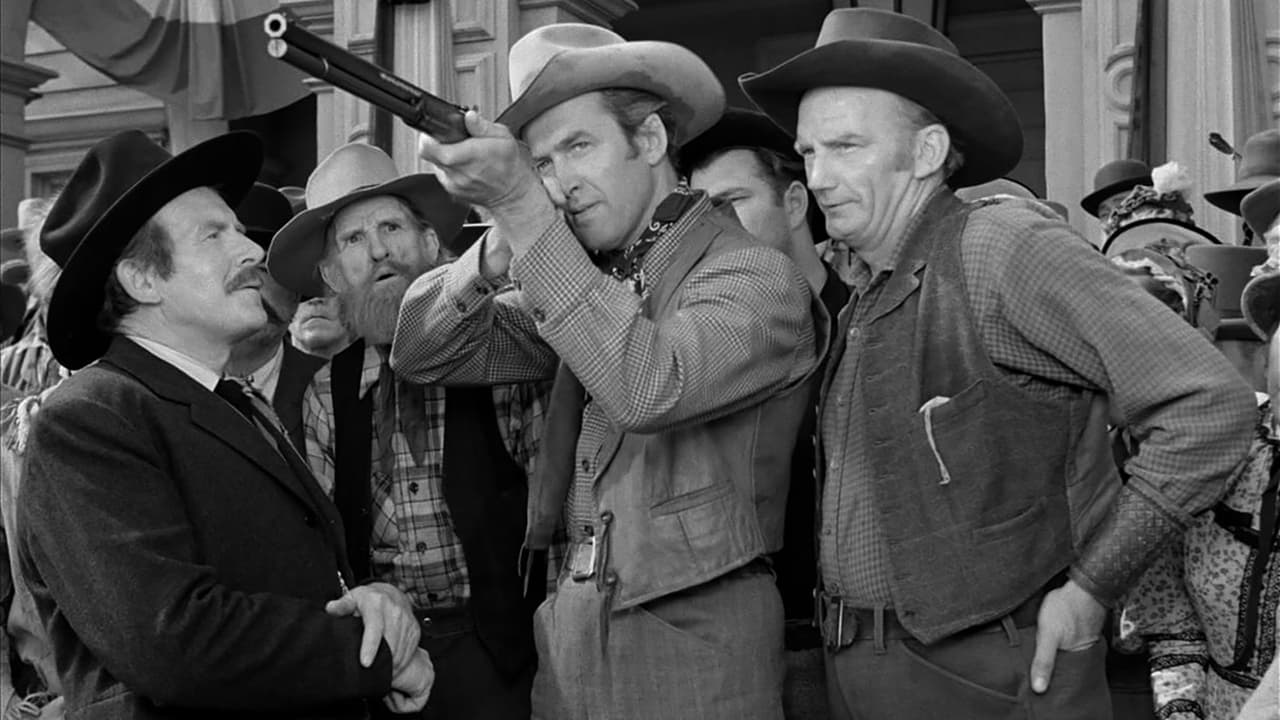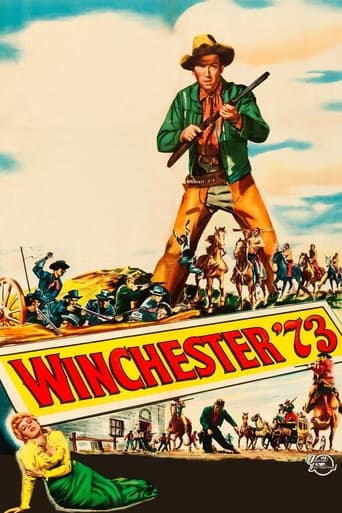

All Five of the Director Anthony Mann/James Stewart Westerns are Excellent Films and there is no need to point out which one is the Best because that would be a very Personal Opinion. This One was the First and it Started the Quintet and helped Reinvent the Western in both Style and Description. The New Wave of the Westerns were Called "Adult...Psychological...Complex", hardly Terms that Prior could or would be used to Describe this American Film Form.Fact is, that Anthony Mann was Overlooked for Decades and it wasn't until the Film School Generation brought the Director to Light and the Acclaim He Deserved. This is a Great Western that may be a bit Heavy on the "Gun-Culture" Gooeyness and the opening Shooting Contest may be Guilty of unneeded Name Dropping, after Things get Going the Movie is Stunning and Riveting in its Action Scenes like the Visceral Indian Attack and the Shootout at the Homestead. These are Violent and Gripping in a way that No Western had done in Terms of Style and Content.The Script is Crackerjack with the way Cowpokes of the Old West Spoke in Short, Choppy Sentences that were Unschooled, but Profound. There are many Quotables and the Characters are Interesting and Dynamically Portrayed. Shelley Winters is a Stand Out as a "Dance Hall" Girl and is Witty as well as Worldly. Dan Duryea is a Heartbeat away from Overripe Playing a Heartless Psychopath, and Millard Mitchell as a Talky Sidekick is Very Good. The Rest of the Supporting Players are all On Their Game.The Climax doesn't Disappoint and the Ricocheting Bullets are, again, Filmed with a Flare with Audio and Visual Effects that Looked and Sounded New and Different. Overall this one is Essential and Seminal in the Western Pantheon. One of the Best.
... View MoreTwo classics appeared in 1950: Winchester '73 and me. Well, I may not be a classic, but this film is. A western born out of film noir with blurry morals instead of the clear black and white we are so used to seeing.This was the first of five classic collaborations between Anthony Mann and James Stewart. Bend of the River came two years later, followed by The Naked Spur, The Far Country and The Man From Laramie in each of the next three years.The film features a young Shelley Winters as a dance hall girl who is looking to settle down. Her intended doesn't quite measure up, but Stewart is there for the rescue.With Dan Duryea, Will Geer, and Rock Hudson as an Indian Chief, it is well worth your time, as are the four that follow.
... View More*Spoiler/plot- 1950, Frontiersman Lin McAdam is attempting to track down both his father's murderer and his special repeating rifle, Winchester '73. This rifle passes among a diverse group of desperate characters. Some of these are: crazed highwayman, immoral gunrunner, savage young Indian chief, and McAdam's brother.*Special Stars- James Stewart, Shelley Winters, Dan Duryea, Steven McNalley, Will Geer, Jay C. Flippen. Rock Hudson, Tony Curtis. Dir: Anthony Mann *Theme- Rifles don't really kill people, bad people kill good people.*Based on- A screenplay.*Trivia/location/goofs- James Stewart has credited Winchester '73 for helping to save and redefine his career, after a series of post-war flops which threatened to damage his career. This is the film Mr. Stewart would first find and use as his favorite horse called, 'Pye'. Pye was part Quarter and Arabian horse. This horse became his screen partner in his 30+ years Western film career. He never owned this horse but was loaned by a friend's daughter. At the time of release there was some ridiculing from the press at the idea of James Stewart, the polished quiet "thin man", could play a tough westerner. But, audience members were heard to audibly gasp in shock at the scene where Mr. Stewart angrily confronts Dan Duryea gunman character at the saloon bar with an arm-twisting. This was a first film role for two Universal upcoming leading men, Rock Hudson (gun buying Indian Chief) and Anthony (Tony) Curtis (2nd Cavalry trooper, Doan).*Emotion- A different film from those that came before. This film stressed character interactions that plain melodrama. It was enjoyable to experience the change of this Western genre into something more watch able. I am happy to own some film prop memorabilia of this film, a medal worn around Rock Hudson neck as an Indian Chief.
... View MoreThis being my first classic western I have little in the way of frame of reference for talking about it. This said by my reckoning its great stuff. A tale of a gun, masterpiece of craft, but more about men and the toil of obsession. Lin McAdam (James Stewart) encounters one Dutch Henry (Stephen McNally) in the town of Dodge City, they have prior quarrel but things really heat up when Lin wins a prized Winchester '73 in a shooting contest and Butch subsequently steals it from him. So the pursuit begins, meanwhile the gun changes several hands. But as things progress we see the film isn't really about a gun. More about Lin and Dutch and their ways, and the places they find comfort. In Dodge City Dutch is at his element, later at a bar we see him about business, schemer playing his options. But in neither place is Lin at home, just the stark desert, just when in pursuit. The obsessed, at disadvantage to the object of obsession and facing uncertainty of what lies beyond. Perhaps the crucial scene of the film has Lin's friend High Spade (Millard Mitchell) querying this uncertainty as they bed down for the night, around them nothing but cold dark, cacti and hills. When obsession is fulfilled what then, can the obsessed yet find comfort? Its a serious question that adds a layer of pathos to our hero, handled very well by Stewart. He's a good man, but a hardened and darkened one, he can charm and appeal to the films notable female Lola (Shelley Winters) who ultimately sees though the facades of all, but there's steel within. Dutch Henry is a potent foil, there's that same steel but more calculation, more mind for ease, looser and more malign. And a good contrast to his fellow evil-doer Waco Johnie Dean (Dan Duryea), smiling and vicious, not being bound by any particular circle of obsession of vengeance entirely assured in his actions. There are other lines to the plot of course, but ultimately its about the leads as slowly they draw together, there are different confrontations but it all comes down to a classic style one on one showdown. The various action scenes are all quality stuff, a thrilling horse chase and a few shootouts, all tensely handled. A fine punctuation to the psychological side of the piece, and in one important scene illustration of the way these men of the old west relate to their environment and to burgeoning civilisation. Of course the film wouldn't work as a psychological piece without astute dialogue, of which there is plenty. Short, straight and timber tough, not a word is wasted, its a great work of characterful writing. I think the final moments could have been slightly better developed, with more of a nod to the ambivalent tone of earlier, but its a fairly minor gripe given the general tone. Quality stuff say I, 8/10
... View More